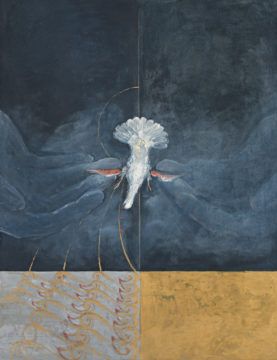Daniel Birnbaum at Artforum:
 In his 1591 treatise De monade, numero et figura liber (On the Monad, Number, and Figure), Bruno described three types of monads: God, souls, and atoms. Much later, the concept of the monad was popularized by Gottfried Wilhelm Leibniz. In Leibniz’s system, monads are the basic, irreducible components of the universe. Each monad is a unique, indestructible soul-like entity. Monads cannot interact, but all are perfectly synchronized with one another by God.
In his 1591 treatise De monade, numero et figura liber (On the Monad, Number, and Figure), Bruno described three types of monads: God, souls, and atoms. Much later, the concept of the monad was popularized by Gottfried Wilhelm Leibniz. In Leibniz’s system, monads are the basic, irreducible components of the universe. Each monad is a unique, indestructible soul-like entity. Monads cannot interact, but all are perfectly synchronized with one another by God.
Did af Klint know any of this when she created “The Atom Series” in 1917, juxtaposing her imagery with such statements as “Every atom has its center, but every center is directly connected to the center of the universe” and “The center of the universe consists of Innocence”? The series would appear to be a survey of the structure of the cosmos, but inner and outer worlds are so intimately intertwined in af Klint’s art that even physics can be described in moral and spiritual terms. The idea of macrocosms that both mirror and are composed of microcosms (universe and atom, body and cell) recurs throughout her notes.
more here.
